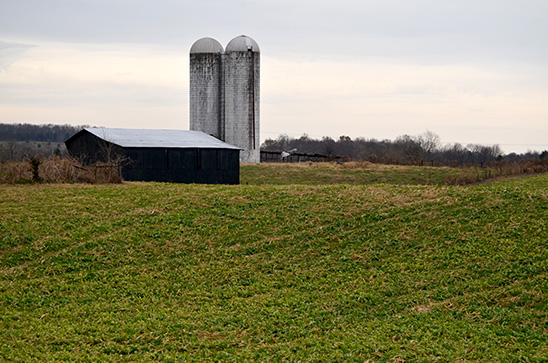Extension brings cover crop education to county
Extension brings cover crop education to county

The rolling hills of Hart County are not what most people would consider a traditional area for growing row crops, but high commodity prices a few years ago resulted in farmers planting corn and soybeans here and throughout much of south-central Kentucky.
Chris Clark, one of the county’s agents with the University of Kentucky Cooperative Extension Service, saw it as a new opportunity for farmers but one that came with challenges, with soil erosion control at the top of the list. To that extent, he and Adam Estes, young farmer program coordinator with Elizabethtown Community and Technical College and Hart County Extension district board member, have offered educational programs to area farmers about using cover crops as a way to save their soil.
“The problem comes in the soybean rotation year,” said Clark, the county’s extension agent for agriculture and natural resources education. “There is just not enough residue cover to control soil erosion. That’s why we have increased our emphasis on cover crops.”
At their meetings, they have discussed various cover crop options and economics. The meetings have been well attended by area growers and landowners who lease their land. Most are interested in incorporating cover crops but are hesitant because of harvest time constraints and planting costs.
“We want to make sure that people know what the options are and what might fit best with their operation,” Estes said. “You don’t necessarily have to have an expensive piece of equipment to put cover crops down. It can be something as simple as driving over the field with a fertilizer spreader with some wheat seed in the back of it and throwing it over top of the ground.”
Clark and Estes found an enthusiastic cover crop advocate in Daniel Wengerd, who grows corn and soybeans with his family in Hart, Green, Metcalfe and Barren counties. Wengerd sewed his first cover crops a decade ago, but the 2012 drought completely sold him on their effectiveness.
“You could see a difference in the fields where I planted cover crops that year, because those fields had more moisture,” he said.
He began ramping up his use of cover crops after that. This winter, about 4,000 of the 5,000 acres he farms have a cover crop “cocktail mix” of wheat, rye, crimson clover and radish. He sees continued environmental improvements on the land that he farms as well as better weed control.
“After a 2-inch rain, there is clean water coming off my fields,” he said. “I see our organic matter slowly inching up and the overall biology of the soil improving, but it hasn’t happened overnight.”
Clark and Estes have featured Wengerd and his family as examples of farmers who have successfully incorporated cover crops into their operation and have taken farmers on a tour of one of his farms.
“People look at them and say it can be done. I think that’s really important,” Clark said.
Clark said he knows farmers are interested in cover crops because of the number of calls and emails he and Estes continue to receive. They plan to offer more programs in the future.
“I think the message is getting there, but there’s going to need to be a continued thrust,” he said. “It’s just not going to be a one-time program.”
Crops Extension


